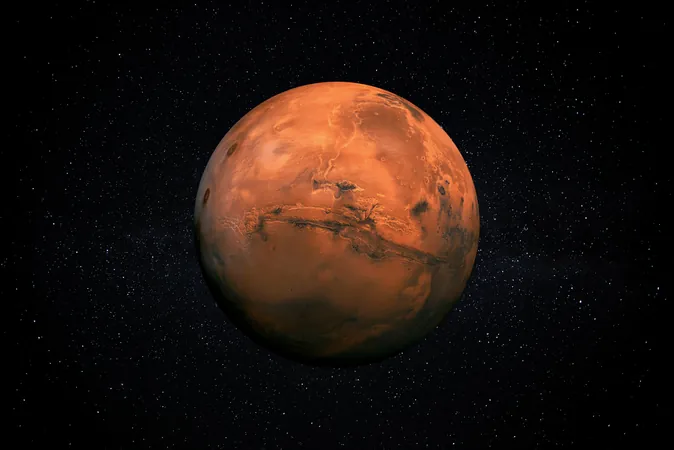
Unlocking Mars: A Stunning New Study Hints at Ancient Life and Volcanic Activity
2025-04-22
Author: Emma
A groundbreaking investigation from Texas A&M University is turning the spotlight on Mars, offering tantalizing hints about ancient life hidden in the planet's rocks.
A Geological Treasure Trove in Jezero Crater
The study focuses on Jezero Crater—NASA's Perseverance rover’s landing site—unveiling an intriguing geological history. Researchers have found that the crater’s floor consists of diverse, iron-rich volcanic rocks, serving as a critical key to unlocking Mars' enigmatic past.
Revolutionary Insights from Advanced Robotics
Launched on February 18, 2021, Perseverance is NASA's most advanced robotic explorer, specifically designed to hunt for signs of ancient microbial life. It is currently collecting core samples of Martian rocks and regolith for potential analysis on Earth in the future.
Equipped with cutting-edge tools, Perseverance is scrutinizing these rocks to uncover their chemical composition and identify compounds indicative of past life. The rover’s high-resolution camera system provides detailed images, and research scientist Dr. Michael Tice highlights the unprecedented depth of new information being uncovered.
Decoding Mars' Volcanic and Hydrological Secrets
Dr. Tice and his research team meticulously analyzed the rock formations in the crater to delve into Mars' volcanic and water-driven history. Utilizing the Planetary Instrument for X-ray Lithochemistry (PIXL), an advanced spectrometer, they examined the Márz formation—a crucial geological region within Jezero Crater. PIXL’s high-resolution X-ray capabilities have transformed our understanding of Martian geology.
"Every rover sent to Mars has been groundbreaking, but this is the first to analyze rocks in such detail with X-ray fluorescence. It reshapes our perspective on Martian rock history," Tice asserted.
Two Unique Types of Martian Rocks
The research uncovered two distinct types of volcanic rocks on the Martian surface. The first, a dark-toned rock rich in iron and magnesium, features minerals like pyroxene and plagioclase feldspar revealing signs of altered olivine. The second type is a lighter rock known as trachy-andesite, characterized by plagioclase crystals embedded in a potassium-rich groundmass.
This complexity suggests that Mars experienced multiple volcanic flows with diverse compositions, ultimately shaping the planet's geological tapestry.
Implications for Life on the Red Planet
Researchers employed thermodynamic modeling to explore how these rocks formed, leading them to hypothesize that a high degree of fractional crystallization—where different minerals crystallize from molten rock as it cools—played a significant role. Moreover, they discovered traits indicating that the lava may have mixed with iron-rich materials from the Martian crust, further altering its composition.
Dr. Tice emphasizes that these processes mirror those seen in active volcanic systems on Earth, hinting that this section of Mars may have experienced prolonged volcanic activity, potentially creating favorable conditions for life.
A Future of Discovery Awaits
The implications of this study are profound. If Mars had an active volcanic system for extended periods, conditions might have once been suitable for life during much of the planet's early history.
"We are meticulously analyzing these rocks because they contain invaluable clues about Mars' past environments. Once we bring them back to Earth and examine them with advanced lab instruments, we can pose much more detailed questions about their history and any signs of biological activity," Dr. Tice concluded.









 Brasil (PT)
Brasil (PT)
 Canada (EN)
Canada (EN)
 Chile (ES)
Chile (ES)
 Česko (CS)
Česko (CS)
 대한민국 (KO)
대한민국 (KO)
 España (ES)
España (ES)
 France (FR)
France (FR)
 Hong Kong (EN)
Hong Kong (EN)
 Italia (IT)
Italia (IT)
 日本 (JA)
日本 (JA)
 Magyarország (HU)
Magyarország (HU)
 Norge (NO)
Norge (NO)
 Polska (PL)
Polska (PL)
 Schweiz (DE)
Schweiz (DE)
 Singapore (EN)
Singapore (EN)
 Sverige (SV)
Sverige (SV)
 Suomi (FI)
Suomi (FI)
 Türkiye (TR)
Türkiye (TR)
 الإمارات العربية المتحدة (AR)
الإمارات العربية المتحدة (AR)